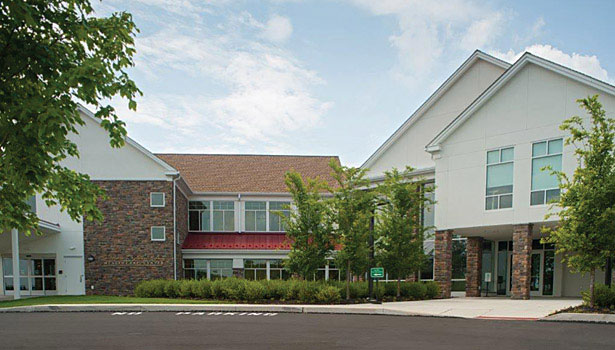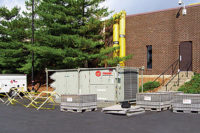A tough economy and scrutinized energy consumption created an ambitious plan to enlarge a mental health facility near Allentown, PA. Engineers and designers were able to successfully exceed energy efficiency and indoor comfort needs by putting together just the right equipment that would work in tandem for best results. The key: smaller, smarter mechanical systems that wrench Btus from super-efficient ground-source heating and cooling systems.
“I don’t know that you’ll find a smarter, more efficient mechanical system than the one now installed at the new Penn Foundation facility,” said Glenn Snyder, P.E.
Snyder was one of several professionals who brought together hundreds of mechanical components to be connected by a modular control network that now serves the 36,000-sq-ft, two-story building.
“Geothermal systems were installed that harvest energy from the earth. But the real uniqueness of this job is the way Btus are removed from or delivered to enclosed spaces,” explained Greg Cunniff, application engineering manager for Taco, Inc.
“Different water temperatures are readily available for a variety of terminal units throughout the facility from a single-pipe system because we’re using new, off-the-shelf injection mixing blocks that blend supply and return water temperatures from the main,” continued Cunniff. “Injection mixing provides the perfect balance of everything designers, installers, and building owners most want.”
The facility’s parking lot conceals 48 geothermal bore holes. The holes are on 20-ft centers, and each circulate fluid to a depth of 300 ft. The well field uses Taco’s KS series vertical in-line pumps to save space in the mechanical room.
The bore holes provide ground-temperature water to five, 28-ton water-to-water geothermal heat pumps. The units stage on and off, depending on current load requirements.
The geothermal systems are connected to 176 chilled beams (88 zones), eight fan coil units to condition high-load interior spaces, and 10 water-to-air heat pumps to handle entry doors with high infiltration. A single-pipe distribution system is tied to Taco’s LOFlo™ injection mixing blocks.
Taco’s iWorXTM control system carefully monitors room temperature, supply water temperature, and everchanging dew point, and circulators connected to the stainless steel mixing blocks. The new BAS also controls circulation in the geothermal exchange field, water-to-water units, DOAS, and all remote heat pumps.
The facility’s fresh air is supplied through the chilled beams, via the DOAS, which in turn increases the capacity of the beams. Active chilled beams use a combination of air supplied from the DOAS and the airflow from natural convection to either heat or cool the space.
Active chilled beam systems, like those installed by mechanical contractor IT Landes at the Penn Foundation, can approach 400 Btuh/sq ft.
Snyder, a vice president with Lederach Associates, an architecture and engineering firm, said that Phillip C. Lederach, president of the firm, did the architectural work at Penn Foundation, while he and his associate, Jason Lutchendorf, did the mechanical system design.
According to Snyder, an all-air, ducted system was out of the question because of the space required for larger ducts.
“The single-pipe, LOFlo system was the winning design,” said Cunniff. “This reduced the number of pipes from four to two — one for heating, and one for cooling.”
When compared to a conventional chilled beam system, the use of LOFlo decreased the flow rate by almost 75%, Cunniff continued.
“So we dramatically reduced the number of pipes and substantially reduced their size,” Cunniff added.
“Energy costs are substantially lower and so are the maintenance costs,” said Lutchendorf.
The iWorX, chilled beam, and geothermal combination is estimated to provide a $12,000 yearly energy savings over a standard water source heat pump system. An annual maintenance savings of $3,000 is also estimated.
“Using Taco’s HSS [Hydronic Solution Software], we designed the majority of the system piping and cascading temperatures throughout the entire system. We were pleased with how easy the program was to use,” said Lutchendorf.
The Penn Foundation facility addition uses a total of 98 LOFlo mixing blocks, 88 of which are coupled to chilled beams in the 1,000 to 6,000 Btu size range.
“A project like this is simplified only when the control system is ideally suited to all of the components that must work in tandem,” said Pitcairn. “iWorX modules are designed for specific functions, including chilled beam and geothermal system operation. This was exactly what Penn Foundation needed.”



